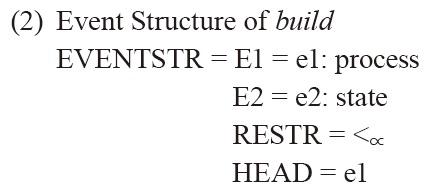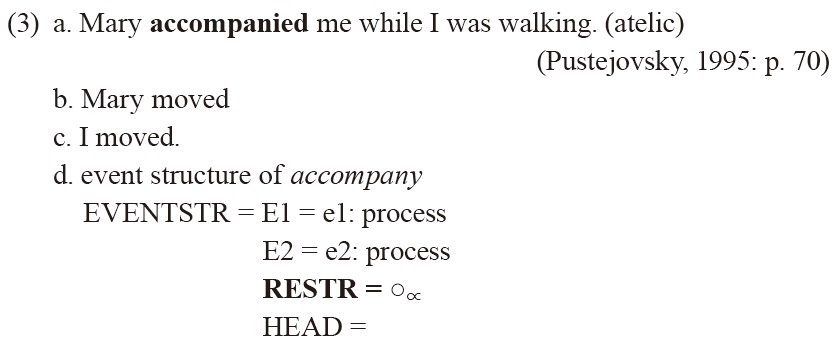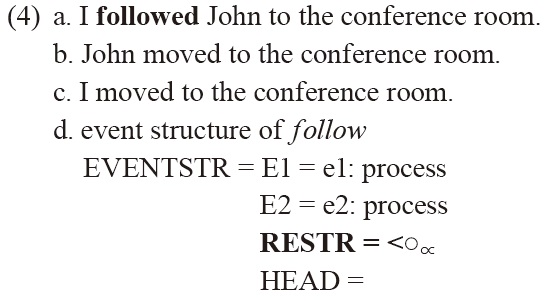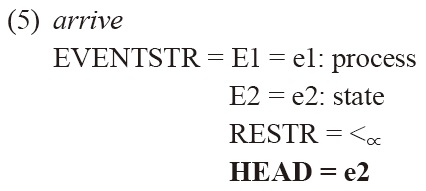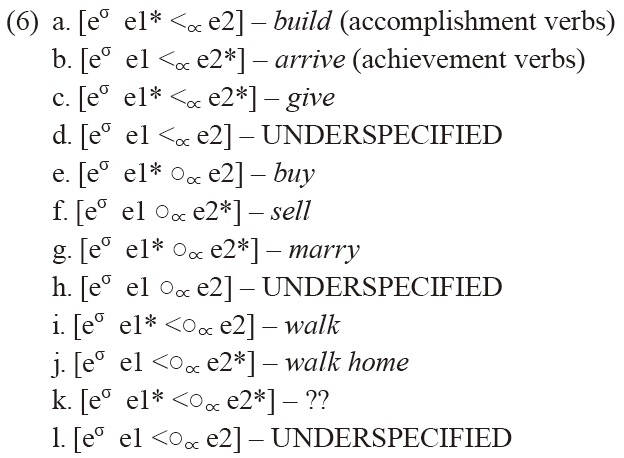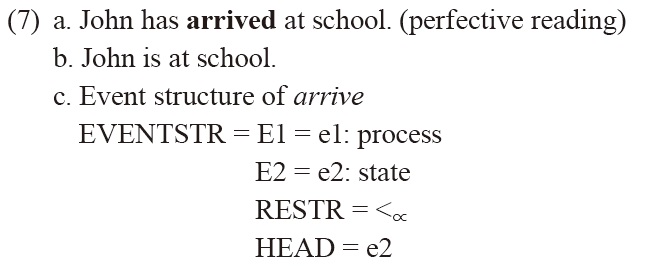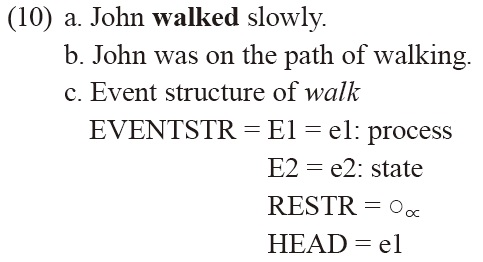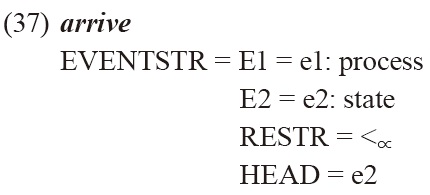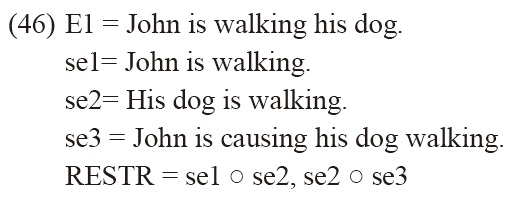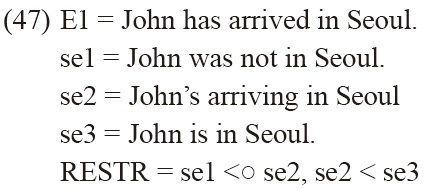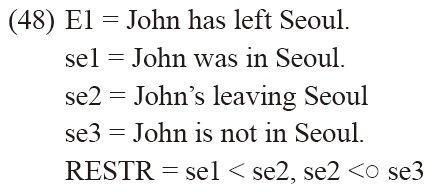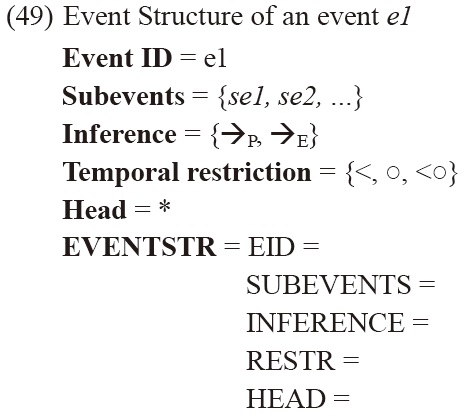


Event structure, in the Generative Lexicon (hereafter, GL), is a representation level designed to capture lexical aspectual properties of event-denoting expressions. In this paper, I propose to extend event structure by incorporating
There are several motivations for positing lexical inferences as part of event structure. First, event-related lexical inferences offer a standard for classification of event-denoting expressions. For instance, the event structure of creation verbs such as
The creation verb
Based on the event structure in (2), we cannot exactly capture what changes from what to what, because it does not provide information about lexical inferences of
Secondly, a semantic relation between verb pairs such as
The paper will proceed as follows; I introduce event structure and its components of the GL in section 2. In the following two sections, I describe various types of lexical inferences to support the proposal of this paper. Section 3 is about lexical entailments and section 4 about lexical presuppositions. In section 5, I propose a modified event structure. Section 6 is for conclusion and discussion of future research.
2. Event Structure in the Generative Lexicon
In the GL, event structure is a structured list of events with their types (aspectual classes), the ordering restriction over the events, and the property of headedness. Regarding event types, the GL assumes that subevents can be classified into at least three sorts: processes, states, and transitions. The event structure of process or state verbs is a simplex structure composed of only one subevent. When the event type of an event-denoting expression is a transition, its event structure is a complex structure with plural subevents.
The ordering restriction over event structure represents temporal and mereological (
Given that the event e3 is a complex event structure constituted of two subevents, e1 and e2, the relation of exhaustive ordered part of (<∝) states that e1 temporally precedes e2, each is a logical part of e3 and there is no other event that is part of e3 (See the event structure of
The event structure of accompany, when it is interpreted as a motion verb, in (3) has two process subevents which happen simultaneously. The relation
Unlike
In addition, event structure of the GL has a way of representing the relative prominence of a subevent comparing with other subevents. The head is the most prominent subevent in the event structure of a predicate. For instance, the head is assigned to the process subevent e1 for accomplishment verbs such as
Based on the conceptual design of event structure described above, Pustejovsky (1995) presents twelve kinds of event structure types as shown in (6).
Distinction between accomplishment and achievement verbs depends on the headedness property of the verb classes (See 6a and 6b). (6c) illustrates events involving a subclass of ditransitive transfer verbs such as
Until now, I explained event structure of the GL in brief. Event structure needs to include lexical inferences of event-denoting expressions in order for it to capture better the lexical meaning of the expressions. In the next two sections, I show several types of lexical inferences. Section 3 treats lexical entailments based on event structure.
1This analysis of the verb walk can be arguable. I do not discuss about it in detail here. I just consider walk to have the event structure composed of a process and a state which are simultaneous.
3. Event-Related Lexical Entailments
In this section, I explore various types of event structure-related lexical entailments. First, a result state is a subevent in the complex event structure of transition (change) verbs. The GL implies a lexical entailment relation between an event and its result state.2 I suggest to represent the entailment relation explicitly. Secondly, some motion verbs have a lexically entailed state – being on the path –, which is simultaneous to the other subevent with a process event type. Section 3.2 discusses this type of entailment. Thirdly, some causative verbs which belong to a process or an accomplishment aspectual class entail a process subevent. In section 3.3, I analyze the lexical entailment of those verbs.
3.1 Result States as Lexical Entailment
Most complex event structures consist of a process and a result state. See the event structure of the change-of-location verb
In (7c), e1 represents the process of John’s arriving and e2 the result state that John is at school. The sentence in (7a) entails semantically the sentence in (7b) which denotes the result state e2, since the latter is always true when the former is true.3 That is, if John has arrived at school, John is necessarily at school as a result. The entailment is based on the event structure of the verb
The sentence
The conjunction of the two sentences in (9a) is semantically odd but that in (9b) is acceptable. The conjunction test shows that the sentence
3.2 Other Lexically Entailed States
In addition to change verbs that have a lexically entailed result state, there are other verb classes with a lexically entailed state in their event structure. Motion verbs such as
The sentence which denotes John’s walking in (10a) entails the sentence in (10b), since if John walked slowly, then it is true that John was on the path of walking. In (10a), the walking path is not realized syntactically. But it is considered as a default argument, in terms of the GL, which is logically necessary for the verbs which denote motion events. The path of moving is syntactically realized in the following sentence in (11).
The prepositional phrase headed by
Another example is a change-of-location verb such as
From the test of presupposition in (12) and (13), we conclude that the sentence
However, every change-of-location verb does not have a lexically entailed state mentioned above. For example, the verb
The path of the patient’s moving is not exactly captured by the sentence in (14). The verb
To sum up, I argued that most motion verbs whose aspectual class is a process or an accomplishment have a lexically entailed state – being on the path of moving – which is simultaneous with the process of moving. However, motion verbs which belong to the achievement aspectual class do not entail the state – agent’s being on the path –, because a path argument is not necessary logically for them. Until now, I showed some verbs which entail a state subevent. However, some verbs entail a process subevent lexically. In the next section, I show the examples of verbs which have a lexically entailed process subevent in their event structure.
3.3 Lexically Entailed Processes
In this section, I show lexically entailed processes. First, causative motion verbs such as
The sentence
In (16), John’s guiding of me to the conference room entails moving of both John and me to the conference room.
The presupposition test in (17) shows that the verb
3.4 Lexically Entailed Transitions
In the introduction, I pointed out that the semantic relation between
If John killed Mary, she has died. But it is not true that she has died in the case that John did not kill Mary. Therefore, the verb
Although the verb
Another interesting example of a lexically entailed transition is the so-called interaction verbs such as
If John lead me to the conference room, it is true that I followed John to the conference room. Therefore, the verb
I point out that a specific analysis of the verb groups which have lexical entailments is not the aim of this paper. What I focus on here is the argument that event structure should represent the lexical entailments mentioned above. There can be many verb classes which entail various kinds of subevents lexically and we need to study which verb class has what kind of lexical entailments. I leave the issues for the future research. I turn to event-related lexical presuppositions in section 4.
2Recent versions of the GL such as Pustejovsky and Moszkowicz (2008) imply more positively the lexically entailed states, as pointed out by a reviewer. A main focus of this paper is to represent lexical inferences including lexical presuppositions as well as lexical entailments explicitly in the event structure. Moreover, I think the types of inferential relations between an event and its proper subevents should be encoded as a component of event structure. Of course, many issues resulting from this change, including relations to other representation levels such as argument structure and qualia structure, must be studied carefully in the future. 3I define an entailment relation semantically, following the GL (Pustejovsky 1995: p. 24). An expression A semantically entails B if and only if every situation that makes A true, makes B true. 4I adopt the definition of semantic presupposition. A semantically presupposes B if and only if both (a) in all situations where A is true, B is true, and (b) in all situations where A is false, B is true (Pustejovsky 1995: p. 24). 5As a reviewer pointed out, examples of causative-unaccusative alternations of the kind ‘John walked’ vs. ‘John walked his dog’ or ‘john broke the vase’ vs. ‘The vase broke’ have been analyzed as instances of subevent foregrounding within the same event structure in a number of previous studies including the GL and Pustejovsky and Busa (1995). Nevertheless, the examples presented in this paper assume a separate event structure for each of them. In this paper, I take a neutral position and leave it for the future research since the main purpose of this paper is to show the motivations for introducing lexical inferences into event structure and propose a modified event structure.
4. Event-related Lexical Presuppositions
In this section, I explore two types of lexical presuppositions: processes and states. There are some previous studies that mention lexically presupposed processes. In section 4.1, I show a preparatory process for durative achievement verbs, suggested by Caudal (2005), as an example of a lexically presupposed process. Section 4.2 describes another type of lexically presupposed process that Engelberg (2006) observed. Finally, I introduce several kinds of lexically presupposed states in section 4.3.
4.1 Preparatory Processes for Durative Achievement
Verbs Caudal, in his research paper about the Stage Structure Theory (2005), suggests a preparatory stage as a lexical presupposition for a special kind of achievement verbs named durative achievement verbs.6 According to Caudal (2005), preparatory stages are causal stages instantiated for some types of atomic (so-called ‘punctual’) telic situations.7 It is a traditional point-of-view on achievement verbs that they do not have a durative process in their event structure. Consider the data from Martin (2010) and Caudal (2005) below.
Achievement verbs are incompatible with adverbs of completion such as
Nevertheless, achievement verbs such as
Several researchers argue that the kind of achievement verbs are in fact durative ones which presuppose a durative process that prepare for the culmination of the whole event (Caudal 1999, 2002; Kearns 2003; Engelberg 1999, 2000; etc.). I show an example below to help readers understand what a preparatory process is.
When the sentence in (24a) is true, the sentence in (24c) is true. The sentence
4.2 Other Lexically Presupposed processes:
The lexically presupposed processes described in this section are different from the preparatory process (or stage) mentioned above, in that it is not a preparing process for culmination of the core event but just an independent presupposed process. Engelberg (2006) shows an example of the lexically presupposed process. Consider the German verb
Both sentences in (25a) and (25b) entail the sentence in (25c). Therefore, the verb
According to Engelberg (2006), verbs of interaction like
In this section, I showed examples of lexically presupposed processes observed by Engelberg (2006). I agree with Engelberg (2006) about the lexical presuppositions presented in this section. The next subsection turns to lexically presupposed states.
4.3 Lexically Presupposed States
I present another type of lexical presupposition – a lexically presupposed state in this section. All verbs denoting change are supposed to have a (or more) lexically presupposed state(s), since they have the meaning of change 9 The Lexical Event Structure (LES) is a structure which represents lexical semantic information in the lexical semantic theory, named the Lexical Event Structure Theory, developed by Engelberg (2004, 2006). from a state to another state. For example, the change-of-location verb
If the sentence in (27a) is true, the sentence in (27b) is also true, since it is impossible for John to be on the summit until John reaches the summit. When the sentence in (27c) is true, the sentence in (27b) is true, too. The test of presupposition shows the sentence in (27b) represents a lexically presupposed state subevent of the event denoted by the sentence in (27a). See a conjunction test for presupposition in (28).
The conjunction test in (28) shows the state of John’s not being on the summit is a presupposition of the event of John’s reaching on the summit.
Another group of change-of-location verbs also presupposes a state before an event happens. The verb
In (29a), the sentence
Another motion verb
Before the passing event began, John was not on the bridge. If John was already on the bridge, John could not begin passing the bridge. Under the negation of the sentence in (30b), the sentence
Until now, I explored the lexically presupposed states of change-oflocation verbs. I apply the idea of a lexically presupposed state to all change verbs with complex event structure such as change-of-state and change-ofpossession verb classes. Creation verbs such as
Since the sentence in (31c) is true if the sentence in (31a) is true, the former entails the latter – a resultant state of the building event. The sentence in (31b) is a presupposition of the sentence (31a). See the sentences in (32)
Because both (32a) and (32b) entail (32c), the sentence (32c) is a presupposition of the sentence (32a). The presupposition relation results from the lexical semantic property of the creation verb
Since a change-of-possession verb represents that a theme moves from its possessor to another person, the event denoted by a verb in the class presupposes that someone possessed a theme before the change of possession. I show an example of the typical change-of-possession verb
The change-of-possession verb
Under the negation of the sentence (33a), the sentence
Until now, I described various kinds of lexical inferences of verbs related with their event structur 11 . Based on the observation, I suggest a modified version of event structure in which lexical inferences are encoded.
6See Caudal (1999) for a full account of durative achievement verbs. I doubt if the preparatory process for the durative achievement verbs is a necessary subevent in the event structure of the verbs. The issue may be related with various questions:what is defined as a presupposition?; what kind of information should be included in the event structure of a lexical item?; how different is lexical semantics from lexical pragmatics?; etc. I leave the issue for the future research. I just cite Caudal (2005) and Engelberg (2006) in order to motivate the incorporation of various kinds of lexical presuppositions into event structure. 7Caudal does use the terms stage and situation instead of subevent and event, respectively in his Stage Structure theory (Caudal 2005). 8This issue is closely related with his idea about salience. I leave it for the future research. 9The Lexical Event Structure (LES) is a structure which represents lexical semantic information in the lexical semantic theory, named the Lexical Event Structure Theory, developed by Engelberg (2004, 2006). 10Assuming it is impossible that both John and Mary have the book at the same time, the two presuppositions might be complementary and thus representing both in the event structure of give may be logically redundant. However, the assertion is arguable since there are many things people can share. For instance, informationlike things can be shared by many people at the same time. Even though a person give an information to another person, (s)he still has the information. I do not delve into the issue here. 11There are restitutive verbs with the prefix re- which presuppose the occurrence of an event. Since the analysis of the verbs is not so simple, I will prepare a research paper for the verbs in the future. Refer to Marantz (2007) and Wunderlich (2001) for the morpho-syntactic and semantic approaches. In addition, the research papers about the adverb again and its presupposition (Pederson 2014; Dobler 2008a, 2008b) will give some insight to the study of restitutive verbs.
In section 5.1, I discuss why lexical inferences should be represented in the event structure. I reconsider how to partition an event in section 5.2. Section 5.3 discusses how to incorporate event-related lexical inferences into event structure in the GL and what should be changed as a result of the incorporation, focusing on the mereological treatment of event structure, ordering restriction, and headedness. In the last section, I show the modified event structure frame as a summary.
5.1 Why do Lexical Inferences have to be encoded in Event Structure?
Why do the lexical inferences need to be incorporated into event structure? All kinds of lexical inferences are not necessarily related with event structure. Compare the verbs
The two sentences in (35) have a mutual entailment relation between each other. However, the entailment relation does not rely on the event structure of
On the contrary to the lexical inference mentioned above, the eventrelated lexical inferences are only derived by a subeventual analysis of the event denoted by a verb. For instance, I analyze the inferences of the sentence in (36a).
The sentence in (36a) presupposes the sentence in (36b) and entails the sentence in (36c). Both the presupposition and the entailment are based on the event structure of the creation verb
The event denoted by an expression, if it has a complex event structure, is usually decomposed to two subevents: e1 (process) and e2 (result state). The achievement verb
However, I showed that there are more than two subevents in the event structure of verbs of change. Event structure does not need to be a bipartite structure. I define event structure as a structured list of event parameters, following the GL. Nevertheless, event structure can be roughly considered to have three semantic parts below.
Although the number of subevents is not restricted quantitatively, pragmatic inferences cannot be encoded in the event structure. Lexical inferences should be distinguished from pragmatic (contextual) inferences and event structure has to include only lexical inferences. Nishiyama & Koenig, in their paper about a perfect state (2004), separated the lexical entailment (38a) from the conversational implicature (38b) for the sentence
According to them, the state that Ken’s leg is broken (38a) is a subevent in the event structure of
In addition, I reject the approach that treats a culmination as a separate subevent and postulates a tripartite event structure (Moens & Steedman 1988, Kamp & Reyle 1993, and the VerbNet group (Dang et. Al. 2000, Kipper et. Al. 2000)). Consider the event structure of the verb
According to the diagram in (40), the event structure of
5.3 Relations between an event and its subevents
In section 5.3, I explore the relational properties of components of the modified event structure. Event structure in the GL has mereological (part-of) relation, order restriction, and headedness as its relational properties. In 5.3.1, I suggest to withdraw the mereological treatment of event structure.
5.3.1 Mereological Treatment of Event Structure
The original approach to event structure in the GL adopts the mereological treatment of the relation between an event and its subevents. That is, all subevents are exhaustive parts of an event. However, researchers such as Caudal criticize the mereological analysis of event structure.12 I do not delve into Caudal’s argument about the
Under the aspectual verbs
I point out that my analysis is slightly different from Pustejovsky (2000) regarding the temporal ordering relation between an event and its lexically presupposed subevents. Pustejovsky (2000) only considers the time interval in which an event occurs. However, I assume that its lexically presupposed subevent is already in progress when an event begins, considering the time interval before the occurrence of an event.14 The lexically presupposed subevent does not need to terminate necessarily when an event begins.
5.3.2 Semantic Relation between Presupposition and Entailment
Superficially, the relation between presupposed states and entailed result states based on event structure might seem to be just a logical negation relation. Consider the lexical presupposition and the lexical entailment of the verb
It is true that the presupposition in (42b) is a logical negation of the entailment in (42c). However, the semantics of opposition (Pustejovsky, 2000) for change verbs provides the grounds of the argument that the opposition relation between the presupposed state and the entailed result state is not simply a logical relation. The logical negation is derived from the lexical semantic property related with subeventual analysis of change verbs. Pustejovsky (2000) proposes the
Pustejovsky (2000) argues that the effect of the activity of fixing the faucets will render the description
A finer model of change is needed within semantic theory to handle such phenomena. Furthermore, this model must incorporate the properties of
There are two kinds of opposition structure: binary opposition and polar opposition. When there are only a term and its opposition and there is no middle term between them, the opposition structure is a binary opposition. In that case, if the negation of a term has its lexical form, it also is a binary opposition. On the other hand, if there are middle terms between two polar terms, the opposition is a polar opposition. I show examples of opposition structure in (45).
The opposition relation between presuppositions and entailments is not simply a logical negation in the modified event structure. Rather, the relation reflects the crucial lexical semantic property of change verbs. In the next subsection, I mention the temporal ordering restriction and headedness.
5.3.3 Temporal Ordering Restriction and Headedness
The temporal ordering restriction in the GL is still important to define the relations among subevents in the modified event structure. I adopt the three temporal ordering relations in the GL: precedence (<), overlap (◯), and ordered overlap (<◯). Consider the following examples.
In (46), the causative verb
The change-of-location verb
I keep a temporal ordering restriction as a component of the modified event structure.
Because the modified event structure I propose here is roughly composed of three parts, headedness also may be more complicated than that in the GL. I have some questions about headedness. First, is the headedness a necessary component of the modified event structure? Second, what would be the role of headedness? What would be the relation between headedness and Caudal (2005)’s salience? Caudal (2005) argues that the headedness cannot account for the salience relation of subevents. Comparing between headedness and salience will give an insight to research on headedness in the modified event structure.
5.4 A Modified Event Structure Frame
I proposed that event structure should include lexical inferential relations between an event and its subevents. In order to support the proposal, I presented many types of lexical presuppositions and entailments which are related with the event structure of verbs. In addition, I suggested to withdraw the mereological treatment of event structure. Although the event structure need not to be a bipartite structure, it should include only event-related lexical inferences and exclude the other inferences. For now, temporal ordering restrictions between subevents and headedness remain as components of the event structure. Considering what I mentioned, I show the modified event structure frame below.
The subscripted Prepresents a presupposition and the subscripted E means an entailment. The inferential relations between an event and its proper subevents are encoded by INFERENCE in the modified event structure. I show the modified event structure of the verb
The event structure of
12Caudal (2005)’s critic point is that the mereological treatment of event structure cannot account for the salience. 13A reviewer pointed out that the examples with aspectual verbs such as begin and finish do not necessarily prove that the event of building only includes the process. But I think if subevents are temporally parts of a matrix event, the test with aspectual verbs is appropriate. A problem is what kind of criterion should be applied to decide the boundary of an event. This will be one of the future research topics. I will study more research including Piñón’s work on mereological treatment of event structure. 14The beginning time of a lexically presupposed subevent is usually unknown. 15Since the end point of the arriving is the beginning point of the result state, the temporal restriction might be an ordered overlap (<◯).
The aim of this paper was to propose that lexical inferences be incorporated into event structure. In order to support the proposal, I described various kinds of lexical inferences including entailment and presupposition.
Incorporating lexical inferences into event structure results in various changes regarding event structure in the GL. First, an event does not have a part-of relation to its subevents. Rather, the relation between the two is defined as an inferential relation. Secondly, event structure can have as many subevents as possible but the subevents must be event-related lexical inferences, not contextual implicatures. In addition, event structure roughly consists of lexical presuppositions, a core process, and lexical entailment. Thirdly, a temporal ordering restriction can be more complicated than that of the GL because it must show temporal relations between all subevents. Fourthly, headedness also becomes more complicated or it might be changed (or removed). These issues remain for the future research. As well, classification of lexical inferences depending on different verb classes is one of interesting future works.
In spite of many issues not solved yet, I think this research will give some challenge to event structure theory, specially the GL. Furthermore, this work is very useful for textual inferences tasks in computational linguistics, as shown already in Im (2013). Stede (1996) also includes pre-state, activity, and post-state in the event structure of a transition event.

